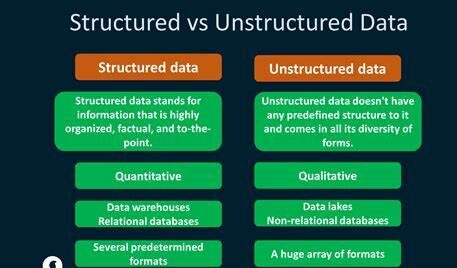Structured data vs semi-structured data—two concepts that dominate discussions in data management. In our digital era, these formats are crucial for storing, analyzing, and managing information. Understanding these data types provides clarity in decision-making, especially when handling large datasets for various applications.
In this article, we will delve into the nuances of structured and semi-structured data, exploring their strengths, weaknesses, and the specific scenarios in which they excel. This knowledge will empower you to make informed decisions on data management strategies, whether you’re analyzing customer data, managing databases, or developing a data-driven application.
Table of Contents
ToggleWhat is Structured Data?
Structured data refers to information that is highly organized and follows a predefined format or schema. Every element in structured data has a designated place, making it simple to store, retrieve, and process. This data format is similar to a well-organized library, where each book is categorized and stored in a specific location.
Characteristics of Structured Data
- Predefined Schema: Structured data adheres to a rigid schema, meaning data types and fields are defined in advance.
- Consistency: Data remains consistent, making it easier to manage and interpret.
- Ease of Access: Information can be quickly retrieved using SQL queries and similar tools.
- Data Integrity: Highly reliable for ensuring accuracy and maintaining integrity over time.
Examples of structured data include:
- Relational Databases like SQL, where data is stored in rows and columns.
- Spreadsheets with fixed columns for fields such as date, amount, or category.
- XML and JSON files that follow specific formatting rules, allowing for seamless data sharing between systems.
Strengths of Structured Data
- Efficiency in Querying: Structured data allows for efficient querying and processing, making it ideal for data-intensive applications.
- High Interoperability: Structured formats can be easily integrated with various tools and software, enhancing data interoperability.
- Data Accuracy: A rigid structure helps maintain data accuracy, reducing the likelihood of errors.
- Scalability: Well-suited for large-scale data applications where performance is critical.
Limitations of Structured Data
- Lack of Flexibility: The predefined schema can be limiting when dealing with evolving or non-uniform datasets.
- Time-Consuming Setup: Establishing a schema and setting up the database requires time and careful planning.
- Cost: Scaling up a structured database can be more costly due to its storage and processing requirements.
What is Semi-Structured Data?
Semi-structured data falls between structured and unstructured data. It contains elements of both, providing a flexible format that can store diverse data types. Semi-structured data often lacks a rigid schema but still carries some organizational markers, making it easier to analyze than purely unstructured data.
Characteristics of Semi-Structured Data
- No Strict Schema: There is no strict schema, but the data has tags or markers that provide context.
- Flexibility: It can adapt to changing data requirements without the need for major restructuring.
- Ease of Modification: New fields and data can be easily added without altering the existing structure.
- Combination of Formats: Semi-structured data can accommodate a mix of data types, such as images, text, and numerical values.
Examples of semi-structured data include:
- NoSQL Databases like MongoDB, where data is stored in collections instead of tables.
- Emails which contain both structured information (sender, recipient) and unstructured content (message body).
- Log Files that have a mix of consistent formats and free-text data.
- Social Media Posts, which blend hashtags, mentions, and multimedia content with unstructured comments.
Strengths of Semi-Structured Data
- Adaptability: Ideal for scenarios where data is evolving, allowing for easy updates and changes.
- Speed of Setup: Setting up a semi-structured database is faster, as it requires minimal schema definitions.
- Cost-Effective Storage: More economical for storing varied datasets compared to strictly structured formats.
- Support for Diverse Data Types: Easily handles images, videos, and documents alongside traditional text and numbers.
Limitations of Semi-Structured Data
- Complexity in Querying: Querying semi-structured data can be challenging due to its less consistent structure.
- Potential for Data Inconsistencies: The lack of a rigid schema may lead to inconsistencies in data formats.
- Lower Efficiency: May not be as efficient for large-scale analysis as structured data due to its flexible nature.
- Limited Interoperability: Not all tools support semi-structured formats, making integration more challenging.
Comparing Structured Data and Semi-Structured Data
Understanding the differences between structured and semi-structured data helps determine the best format for specific use cases. Here’s a breakdown of their key distinctions:
Schema and Organization
- Structured Data: Rigid schema, with clearly defined fields. Ideal for scenarios requiring precision.
- Semi-Structured Data: Flexible schema with optional markers, catering to dynamic or unpredictable data environments.
Data Analysis
- Structured Data: Easy to analyze using SQL-based tools. Suitable for traditional business intelligence.
- Semi-Structured Data: Requires specialized tools like MongoDB or Hadoop for analysis. Suitable for big data applications.
Storage and Scalability
- Structured Data: Relies on relational databases, which can become costly when scaling.
- Semi-Structured Data: Uses scalable NoSQL databases, which are more cost-effective for large and varied datasets.
Integration and Interoperability
- Structured Data: High interoperability with existing tools and platforms.
- Semi-Structured Data: May face compatibility issues, but offers greater adaptability to future data requirements.
Applications of Structured and Semi-Structured Data
When to Use Structured Data
Structured data is best suited for scenarios that require:
- High Data Accuracy: When accuracy is crucial, such as in financial reports or healthcare records.
- Standardization: Applications that require standardized formats, like customer relationship management (CRM) systems.
- Relational Analysis: Situations that involve complex relationships between data points, such as data warehouses and business intelligence systems.
When to Use Semi-Structured Data
Semi-structured data excels in situations that demand:
- Data Flexibility: When dealing with constantly changing datasets, like social media analytics.
- Diverse Data Types: Applications that handle multimedia content, such as content management systems (CMS).
- Rapid Prototyping: Ideal for environments where the database needs to be set up quickly, like startups or evolving projects.
Future Trends in Data Management
The digital landscape continues to evolve, and data management strategies are adapting in response. Here are some trends in structured and semi-structured data:
Data Lakes for Big Data Analysis
Data lakes have become popular as they store massive amounts of semi-structured and unstructured data. They allow for advanced analytics using machine learning and AI, making them a valuable asset in big data environments.
Hybrid Database Systems
The rise of hybrid databases that support both structured and semi-structured data provides a unified solution for organizations. These systems offer flexibility without sacrificing the efficiency of structured formats.
Schema-on-Read Approach
For semi-structured data, the schema-on-read approach is gaining traction. This method allows data analysts to define the schema at the time of querying rather than storage, enhancing flexibility.
AI and Machine Learning Integration
AI tools are increasingly integrated with semi-structured data formats to extract valuable insights, providing opportunities for predictive analytics and personalized recommendations.
Conclusion: Structured Data Vs Semi-Structured Data
Both structured data and semi-structured data play vital roles in the world of data management. Structured data provides a foundation of consistency and reliability, while semi-structured data offers the flexibility needed in dynamic environments. Understanding their strengths and limitations enables us to make informed decisions in the digital age. By combining the two formats where appropriate, organizations can leverage the best of both worlds, driving innovation and improving decision-making processes.
For more information on data management strategies, you can refer to Data Management Best Practices.
FAQs
What are the Key Differences Between Structured and Semi-Structured Data?
- Structured Data: Predefined schema, easy analysis, ideal for relational databases.
- Semi-Structured Data: Flexible schema, adaptable for diverse formats, ideal for NoSQL databases.
When Should I Use Structured Data?
Use structured data for applications that require accuracy, consistency, and interoperability, such as financial records and business intelligence systems.
When Should I Use Semi-Structured Data?
Semi-structured data is suitable for dynamic scenarios like social media analytics, web scraping, and evolving datasets.
Can I Use Both Structured and Semi-Structured Data Together?
Yes, many modern systems use a hybrid approach, combining the strengths of both formats to manage diverse datasets effectively.




